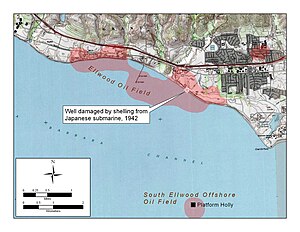Attack on Ellwood
| date | February 23, 1942 |
|---|---|
| place | Ellwood , California , Santa Barbara Canal , Pacific Ocean |
| output | Damage to the oil refinery by the Japanese |
| Parties to the conflict | |
|---|---|
| Commander | |
|
None |
|
| Troop strength | |
| No | 1 submarine |
| losses | |
|
no, |
no |
The attack on Ellwood is the shelling of coastal targets of the United States of America on February 23, 1942 near Santa Barbara , California , which a Japanese submarine launched during World War II . Despite the minor damage, the event sparked fears of an invasion of the west coast of the United States and spurred the decision to intern Japanese Americans . It was also the first shelling of the North American mainland during World War II.
background
After the attack on Pearl Harbor on December 7, 1941, seven Japanese submarines patrolled the American west coast. They attacked several merchant ships and fought two skirmishes with the air or naval forces of the United States Navy . At the end of December, the submarines withdrew to safe waters to fetch supplies. Some drove to Kwajalein , only to go back to American waters afterwards. The I-17 of the Imperial Japanese Navy was one of those boats. The almost 110 m long boat was equipped with six 533 mm torpedo tubes and loaded with a total of 17 torpedoes. There was a 140 mm deck gun on deck. The crew consisted of 101 crew members and officers who were under the command of frigate captain Nishino Kōzō ( 西 野 耕 三 ).
The attack
On February 23, 1942 around 7:00 p.m., the I-17 stopped just before the Ellwood oil field . The submarine's deck gun was aimed at a large Richfield jet fuel tank that sat right on the beach. When the first shots hit one of the refineries, the ear witnesses believed there was an internal explosion, until one of the workers noticed I-17 in the dark and triggered the alarm. The I-17 hit Ellwood Pier, which was slightly damaged, as well as a derrick crane and a waterworks . After twenty minutes of bombardment, in which 12 to 25 of the 140 mm projectiles were fired, the submarine withdrew.
Eyewitnesses reported that the submarine moved south to Los Angeles and sent signal lights towards the coast. The I-17 escaped and the battle ended without any loss of life.
consequences
A blackout was imposed for Santa Barbara until 12:00 noon the following day. News of the attack by a Japanese boat spread across the country. Hundreds of people fled the area; later land prices on this stretch of coast fell to a historic low. The event was used to justify the internment of Japanese Americans, which began two weeks later on March 2nd.
The following night, on February 24, 1942, the Battle of Los Angeles began , in which the US Coast Guard attacked an unknown flying object for hours , which at the time was assumed to be an enemy aircraft.
The Japanese submarines, which were assigned to use off the North American coast, continued to operate against the Allied shipping. Among other things, they attacked Fort Stevens on the Columbia River and shot at a Canadian lighthouse on Vancouver Island . Two air strikes were also launched from a submarine to set off a forest fire in southwest Oregon , but it failed. Despite the order of the Japanese commander to attack capital ships if possible, the submarines only attacked merchant ships and smaller coastal targets.
credentials
- Official Chronology of the US Navy in World War II: Chapter 5, 1942 .
- Otis L. Graham, Robert Baumann, Douglas W. Dodd, Victor W. Geraci, Fermina Brel Murray. Stearns Wharf: Surviving Change on the California Coast. Graduate Prograam in Public Historical Studies, University of California, 1994. ISBN 1-883535-15-8 .
- Jon Parshall, Bob Hackett, Sander Kingsepp. Imperial Japanese Navy Page: HIJMS Submarine I-17: Tabular Record of Movement. Imperial Submarines .
- Bert Webber. Silent Siege: Japanese Attacks Against North America in World War II, Ye Galleon Press, Fairfield, Washington, 1984. ISBN 0-87770-315-9 (hardcover). ISBN 0-87770-318-3 .
